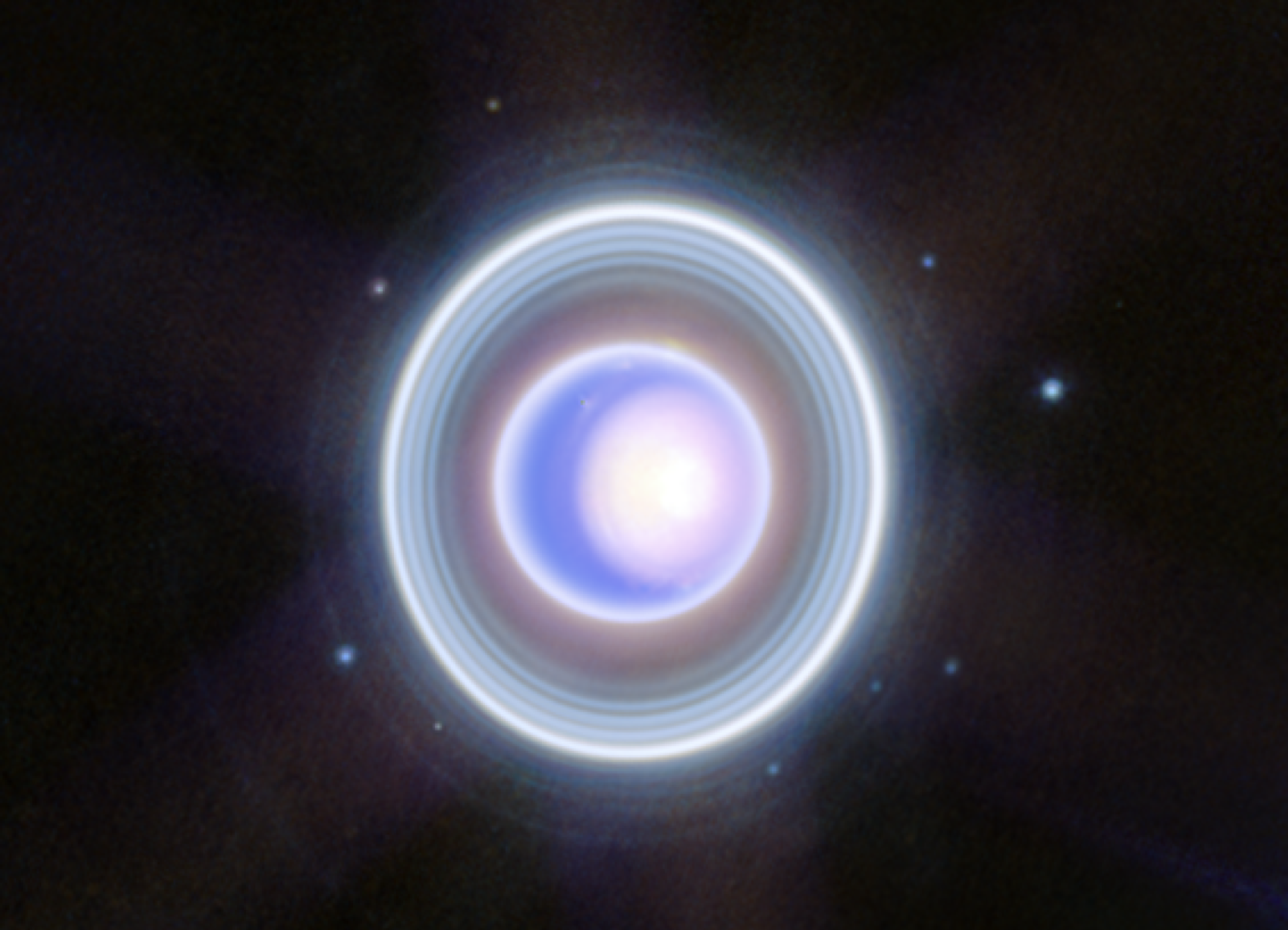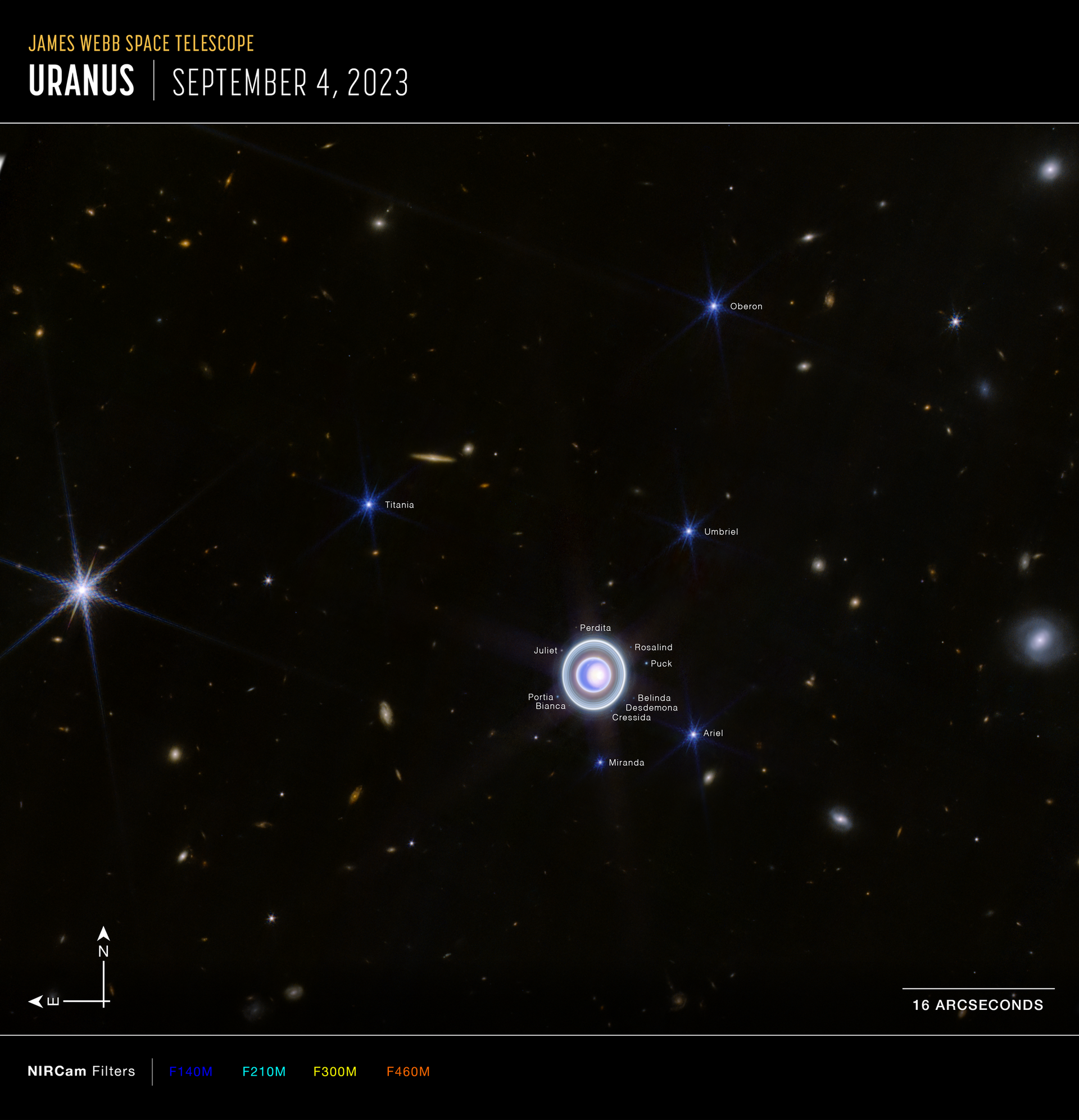https://sputnikglobe.com/20231220/uranus-rings-on-display-in-stunning-new-photo-by-nasas-webb-telescope-1115712351.html
Uranus’ Rings on Display in Stunning New Photo by NASA’s Webb Telescope
Uranus’ Rings on Display in Stunning New Photo by NASA’s Webb Telescope
Sputnik International
While the James Webb Space Telescope was designed for peering into the early universe billions of light-years away, it has also been able to deliver stunning photos of objects in our own solar system using its infrared detectors.
2023-12-20T22:32+0000
2023-12-20T22:32+0000
2023-12-20T22:29+0000
beyond politics
uranus
astronomy
moons
rings
james webb space telescope (jwst)
nasa
https://cdn1.img.sputnikglobe.com/img/07e7/0c/14/1115712491_0:137:1384:916_1920x0_80_0_0_e50121469961b8d5113634228f1c0844.png
Using the infrared spectrum of light, which is invisible to the human eye and emitted by heat transfer, the space telescope was able to capture images of features on and around Uranus rarely seen.In fact, the images released on Wednesday is a much higher-resolution photo from the same set as that released in April, which had just two colors.“The JWST gives us the ability to look at both Uranus and Neptune in a completely new way because we have never had a telescope of this size that looks in the infrared,” Naomi Rowe-Gurney, a postdoctoral research scientist and solar system ambassador for the Webb space telescope at NASA Goddard Space Flight Center, told US media.Uranus and Neptune, the two outermost planets that were unknown to the premodern world, are cold “ice giants” similar to the larger gas giants Jupiter and Saturn, but containing more ices and organic elements like oxygen, carbon, nitrogen, and sulfur. Because of their extreme distance, they have rarely been studied directly, with the unmanned Voyager 2 probe making humankind’s first close-up visit to both worlds in 1986 and 1989, respectively.Voyager 2’s cameras snapped highly illustrative photos of the two worlds in the visible spectrum, but subsequent studies by telescopes on Earth and in Earth orbit, like the JWST and Hubble, have revealed further hidden details.One such discovery made in 2007 was the Zeta ring, a faint inner ring that is easily visible in the JWST photos.Still, Uranus has polar ice caps, which are visible at the center of the planet in the photo. Uranus takes 84 Earth years to orbit the sun, and is approaching its next solstice in 2028, meaning the icy poles are getting more sun than usual. Meanwhile, the far side of the planet is in the middle of a 21-year-long winter.NASA has planned a specialized spacecraft mission to Uranus, which the US space agency hopes to launch by 2030, seeing the bizarre world as “an exoplanet in our own solar system.” However, the crowdsourced naming effort hasn’t gone so well.
Sputnik International
feedback@sputniknews.com
+74956456601
MIA „Rosiya Segodnya“
2023
News
en_EN
Sputnik International
feedback@sputniknews.com
+74956456601
MIA „Rosiya Segodnya“
Sputnik International
feedback@sputniknews.com
+74956456601
MIA „Rosiya Segodnya“
why is uranus on its side, does uranus have rings, nasa uranus photos
why is uranus on its side, does uranus have rings, nasa uranus photos
Uranus’ Rings on Display in Stunning New Photo by NASA’s Webb Telescope
While NASA’s James Webb Space Telescope (JWST) was designed for peering deep into the early universe billions of light-years away, it has also been able to deliver stunning photos of objects in our own solar system using its infrared detectors.
Using the infrared spectrum of light, which is invisible to the human eye and emitted by heat transfer, the space telescope was able to capture images of features on and around Uranus rarely seen.
In fact, the images released on Wednesday is a much higher-resolution photo from the same set as
that released in April, which had just two colors.
“The JWST gives us the ability to look at both Uranus and Neptune in a completely new way because we have never had a telescope of this size that looks in the infrared,” Naomi Rowe-Gurney, a postdoctoral research scientist and solar system ambassador for the Webb space telescope at NASA Goddard Space Flight Center, told US media.
“The infrared can show us new depths and features that are difficult to see from the ground with the atmosphere in the way and invisible to telescopes that look in visible light like Hubble,” she added.
Uranus and Neptune, the two outermost planets that were unknown to the premodern world, are cold “ice giants” similar to the larger gas giants Jupiter and Saturn, but
containing more ices and organic elements like oxygen, carbon, nitrogen, and sulfur. Because of their extreme distance, they have rarely been studied directly, with the
unmanned Voyager 2 probe making humankind’s first close-up visit to both worlds in 1986 and 1989, respectively.
Voyager 2’s cameras snapped highly illustrative photos of the two worlds in the visible spectrum, but subsequent studies by telescopes on Earth and in Earth orbit, like the JWST and Hubble, have revealed further hidden details.
One such discovery made in 2007 was the Zeta ring, a faint inner ring that is easily visible in the JWST photos.
Nine of Uranus’ 27 known moons can also be seen as bright blue and white spheres in the photo. Like the rings, the moons orbit Uranus along its equator, which is tilted 98 degrees thanks to a massive planetary impact early in its life that knocked the planet on its side.
Still, Uranus has polar ice caps, which are visible at the center of the planet in the photo. Uranus takes 84 Earth years to orbit the sun, and is approaching its next solstice in 2028, meaning the icy poles are getting more sun than usual. Meanwhile, the far side of the planet is in the middle of a 21-year-long winter.
Another zoomed-out photo in the set is labeled and shows some of the outermost moons.
NASA has planned a specialized spacecraft mission to Uranus, which the US space agency hopes to launch by 2030, seeing the bizarre world as “an exoplanet in our own solar system.” However, the
crowdsourced naming effort hasn’t gone so well.






